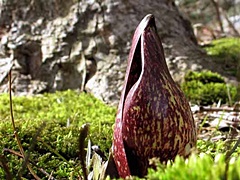
Welcome to Hemlock and Canadice Lakes!
Barns Businesses Cemeteries Churches Clinton & Sullivan Columns Communities Documents Events Time Line Fairs & Festivals Farm & Garden Hiking Homesteads Lake Cottages Lake Scenes Landscapes Library News Articles Old Maps Old Roads & Bridges Organizations People Photo Gallery Podcasts Railroad Reservoir Schools State Forest Veterans Videos
|
“Nature in the Little Finger Lakes” by Angela Cannon Crothers |
|
|
March Brings the Harbingers of Spring Angela Cannon-Crothers March 2017 1. Odoriferous skunk cabbage that roars within the soil, melting snow around its bulging buds, is now in bloom. This flower is shaped like a carnivorous pitcher plant, the toe of the shoe on a mischievous elf, a cardinal hat, or the head of a Parasaurolophus dinosaur. Skunk cabbage supports both the first pollinating insects, and the hunger of emerging black bears who can tolerate the taste of its burn. 2. Early March’s cacophony of red-winged blackbirds, the most common birds in all of North America, that return in flocks to the area. They fill the wetlands with their chorus of “Ok-a-ree!” and distant dreams of steamy days. 3. Sweet sugar maple sap that runs from roots to buds and buds to roots through their cambium, up and down, in a pulse that is surged by freezing nights and warmer days. Squirrels will nibble off the ends of sugar maple twigs in order to cause drips and icicles to form for their own spring treats. The season for tapping maples ends when the ruddy maple buds begin to swell and the sap turns darker. 4. At least one good dump of snow (sometimes in April as well) - a bonus for skiers and for recharging parched groundwater levels. Like most of this winter, heavy snows probably won’t stick around long. 5. Festive scarlet fairy cups are the first fungi to fruit in the spring; the two-inch vessels turn blood-red as they produce their spores in the melting snow. 6. Wood frogs, in the first melted vernal pools of forests and farm fields, begin to quack in a tone similar to ducks to attract a frog mate. Females will lay around 1000 eggs each. 7. Bluebirds begin looking for nesting cavities near open fields around March 10. 8. The equinox occurs on March 20 when the sun crosses the earth’s celestial equator in our planet’s yearly wobble to and fro on its axis. At this point, daylight hours are equal (nearly) across the globe. Such balance, and one-ness with humanity, has inspired cultures throughout the ages. In the Northern Hemisphere this astronomical event often marks the first day of spring (and often with celebration). May we all be inspired, or more balanced, at least! 9. Spring peeper frogs surface from their deep freeze and fill pond lands and seasonal pools with a near deafening, sleigh-bell-like call. 10. Mourning cloak butterflies, who overwintered as adults beneath thick bark or in your house’s clapboards and eaves, now emerge on the first sunny warm days. 11. Woodcocks begin their peenting courtship at dusk around the equinox. 12. Newborn baby red squirrels. Need I say more? 13. From under logs and thick leaf litter, spotted salamanders move slowly in the dark of night as soon as ice recedes from even just the edges of their seasonal breeding pools. 14. Finally, the first raptors are seen soaring the upper air thermals. These glorious birds with upswept wide wings are turkey vultures. They take on the business of cleaning up carcasses from winter’s toll and road kills: from single-minded striped skunks to pavement hopping peepers. But turkey vultures have no spring call, or vocal chords at all; their return is the whisper of a warming, but still blustery, wind. Phenology is the science of recording the dates of seasonal events, an important task during this time of global warming that needs citizen scientists like you! To find out how to get involved, or to learn more, check out The New York Phenology Project at www.nyphenologyproject.org.
|
||
|
Editor’s Note: Angela Cannon Crothers is a naturalist and writer who teaches at Finger Lakes Community College and with The Finger Lakes Museum. Here are some columns that she has written about the Little Finger Lakes. Her columns also appear in the Lake Country Weekender newspaper.
|
||
